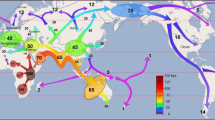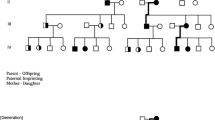Abstract
A recent analysis of literature reports of familial clusters of chronic lymphocytic leukaemia (CLL) suggested that affected offspring are diagnosed at an age 21 years less than CLL parents. Such an analysis risks sampling bias. We avoided these potential sources of bias by systematic ascertainment of CLL families. Statistical analysis of 10 such families showed a significant decline of 22 years between the mean ages at diagnosis of disease in parents and offspring. This confirms the analysis of literature reports and provides the first systematic investigation of a phenomenon which, if familial clustering of CLL cases is considered due to genetic effects, points to familial CLL manifesting anticipation.
This is a preview of subscription content, access via your institution
Access options
Subscribe to this journal
Receive 12 print issues and online access
$259.00 per year
only $21.58 per issue
Buy this article
- Purchase on Springer Link
- Instant access to full article PDF
Prices may be subject to local taxes which are calculated during checkout
Similar content being viewed by others
Author information
Authors and Affiliations
Rights and permissions
About this article
Cite this article
Yuille, M., Houlston, R. & Catovsky, D. Anticipation in familial chronic lymphocytic leukaemia. Leukemia 12, 1696–1698 (1998). https://doi.org/10.1038/sj.leu.2401176
Received:
Accepted:
Published:
Issue Date:
DOI: https://doi.org/10.1038/sj.leu.2401176
Keywords
This article is cited by
-
Familial Leukemias
Current Treatment Options in Oncology (2015)
-
The influence of parental age and gender on anticipation in familial B-Cell malignancies
Medical Oncology (2007)
-
Monoclonal B-cell lymphocytosis (MBL) in CLL families: substantial increase in relative risk for young adults
Leukemia (2006)
-
Generation or birth cohort effect on cancer risk in Li–Fraumeni syndrome
Human Genetics (2005)
-
Dysregulation of apoptosis genes in hematopoietic malignancies
Oncogene (2002)



